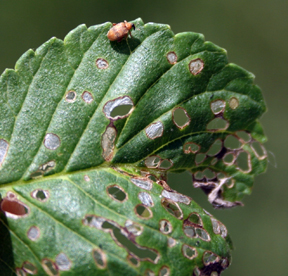Elm flea weevils busy devouring new leaves
Editor’s note: This article is from the archives of the MSU Crop Advisory Team Alerts. Check the label of any pesticide referenced to ensure your use is included.
The Elm flea weevil, Orchestes alni (Coleoptera: Curculionidae), was discovered in Michigan only last year but it seems they are eating the developing leaves of every Asian-type elm I’ve looked at this spring. This beetle was first discovered in the Midwest in 2003 where it has been found in Ohio and Wisconsin. In Michigan, it has been reported in Wayne, Monroe, Genesee and Washtenaw counties but I think it’s a safe bet to say that it can be found throughout southern Michigan at the least. The European elm leaf beetle feeds extensively on elm leaves; it loves Siberian elms.
According to Ohio State University Extension entomologist Curtis Young, the European elm flea weevil, is commonly found throughout Europe. It was first identified in the northeastern United States in 1982. The tiny adult is black or dark brown, or brown with black spots on the back. It has a prominent beak and, like other flea weevils, the hind femurs are enlarged to equip the weevil for jumping. Adults appear in the spring just in time to feed on the underside of newly developing leaves of Siberian elm. They soon begin to lay eggs along the leaf veins. The larvae feed as leaf miners for several weeks before they pupate. Adults emerge throughout the summer and resume feeding on the host elms until they seek overwintering sites on or near the host plants. There is probably only one generation per season.
Control recommendations have not yet been developed for the elm flea weevil though it is thought that imidacloprid, sold as Bayer Tree and Shrub Insect Control for homeowners, applied around the base of the tree should control this pest. This product will take at least four weeks to move through the tree so it should be applied to the soil in mid- to late April or as a trunk injection in early May.



 Print
Print Email
Email





